AUDI A8 2012 Owners Manual
Manufacturer: AUDI, Model Year: 2012, Model line: A8, Model: AUDI A8 2012Pages: 300, PDF Size: 75.06 MB
Page 271 of 300
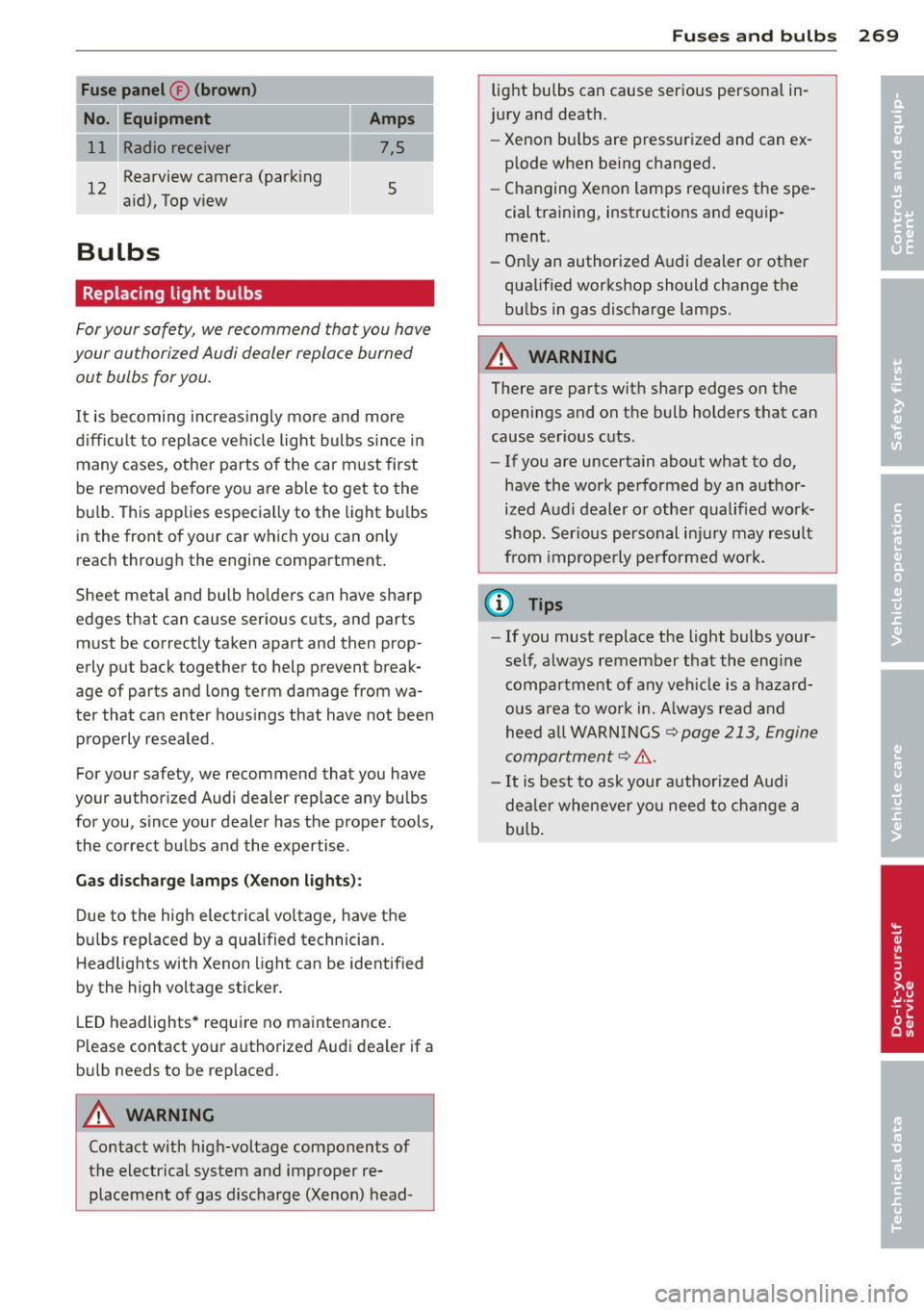
Fuse panel® (brown)
No. Equipment
= 11 Radio receiver
12 Rearview camera (park
ing
a id), Top view
Bulbs
Replacing light bulbs Amps
' ' 7,5
5
For your safety, we recommend that you have
your authorized Audi dealer replace burned out bulbs for you.
It is becoming increas ingly more and more
d iff icu lt to replace vehicle light bulbs since in
many cases, other parts of the car must first
be removed before you are able to get to the
bu lb. This applies especially to the light bulbs
in the front of your car which you can on ly
reach through the engine compartment.
Sheet metal and bulb ho lders can have sharp
edges that can cause serious cuts, and parts must be correctly taken apart and then prop
erly put back together to help prevent break
age of parts and long term damage from wa
ter that can enter housings that have not been properly resealed.
For your safety, we recommend that you have
your authorized Audi dealer replace any bulbs for you, since your dealer has the proper tools,
the correct bulbs and the expertise.
Gas discharge lamps (Xenon lights):
Due to the high electrical voltage, have the
bulbs replaced by a qualified technician.
Headlights with Xenon light can be identified
by the high voltage sticker.
LED headlights * require no maintenance .
Please contact your authorized Audi dealer if a
bu lb needs to be replaced.
A WARNING
Contact with high-voltage components of
the electrical system and improper re
placement of gas discharge (Xenon) head-
Fuses and bulbs
light bulbs can cause serious personal in
jury and death.
- Xenon bulbs are pressurized and can ex
plode when being changed.
- Changing Xenon lamps requires the spe
cial tra ining, instructions and equip
ment.
- On ly an authorized Audi dealer or other
qualified workshop should change the bulbs in gas discharge lamps .
A WARNING
There are parts with sharp edges on the
openings and on the bulb holders that can
cause serious cuts.
- If you are uncertain about what to do,
have the work performed by an author
ized Audi dealer or other qualified work
shop . Ser ious personal injury may result
from imprope rly performed wo rk.
Q) Tips
-If you must replace the light bulbs your
self, always remember that the eng ine
compartment of any vehicle is a hazard
ous area to work in. A lways read and
heed all WARNINGS
~page 213, Engine
compartment
Q & .
-It is best to ask your authorized Audi
dealer whenever yo u need to change a
bulb .
-
269
•
•
Page 272 of 300

2 70 Emergency situations
Emergency situations
General
This chapter is intended for trained emer
gency crews and working personnel who
have the necessary tools and equipment to
perform these ope rations.
Starting by pushing or
towing
Q;) Note
Vehicles w ith an automatic transmission
cannot be started by pus hing o r tow ing.
Starting with jumper
cables
If necessary, the engine can be started by
connecting it to the battery of another vehi
cle.
If the engine should fail to start because of a
discharged or weak battery, the battery can be
connected to the battery of
another vehicle,
using a
pair of jumpe r cables to start the en
g ine .
Jumper cables
Use only jumper cables of sufficiently large
cross section to carry the starter current safe
ly. Refer to the manufacturer's specif ications.
Use only jumper cables with
insulated termi
na l clamps which are distinctly marked:
plus(+) cable in most cases colored red
minu s(-) cable
in most cases colored black .
A WARNING
Batteries contain electricity, acid, and gas.
Any of these can cause very serious or fatal
inju ry. Follow the instructions below for
safe handling of your veh icle's battery.
- Always shield you r eyes and avoid lean
ing over the battery whenever possible.
- A discharged battery can freeze at tem
peratures just be low 32 °F (0 °C). Before connecting a
jumper cable, you must
thaw the frozen battery complete ly, oth
erwise it could explode.
- Do not allow battery acid to contact eyes
or skin . Flush any contacted area with
water immediately .
- Improper use of a booster battery to start a vehicle may cause an explosion.
- Vehicle batteries generate explosive gas
es. Keep sparks, flame and lighted ciga
rettes away from batteries.
- Do not try to jump start any vehicle with a low acid level in the battery.
- The vo ltage of the booster battery must
also have a 12-Volt rating. The capacity
(Ah) of the booster battery should not be
lower than that of the discharged bat
tery . Use of batteries of d ifferent voltage
or substantially different "Ah" rating
may cause an exp losion and personal in
jury.
- Never charge a frozen batte ry. Gas trap
ped in the ice may cause an explosion.
- Never charge or use a battery that has
been frozen. The battery case may have
be weakened.
- Use of batter ies of different voltage or
substantially different capacity (Ah) rat
ing may cause an exp losion and injury.
The capacity (Ah) of the booster battery
should not be lower than that of the dis
charged battery.
- Before you check anything in the engine
compartment, always read and heed a ll
WARNINGS¢
page 213, Engine com
partment.
«I) Note
-Applying a higher voltage booster bat
tery will cause expensive damage to sen
sitive electronic components, such as
contro l units, relays, rad io, etc .
- There must be no electrical contact be
tween the vehicles as otherwise current
could already start to flow as soon as the
positive(+) terminals are connected. ..,_
Page 273 of 300

@ Tips
- The discharged battery must be properly
connected to the vehicle's electrical sys
tem. When jump start ing or charging the
battery, never connect the negative
ground cable to the battery negative post because the battery manager sys
tem must be able to detect the battery's
state of cha rge. A lways connect the neg
ative g round cab le to the negative
gro und post o f the battery manage r con
trol uni t.
Use of jumper cables
Make sure to connect the jumper coble
clomps in exactly the order described below!
Fig. 2 08 Engine compartment: connecto rs for jump
start cables and charger
Fi g. 209 Jump start ing w ith the battery of another ve
hicle: @-booste r batte ry, @ -discharged vehicle bat
te ry
The procedure described below fo r connecting
jumper cab les is intended to provide a jump
start for your veh icle.
Vehicle with discharged batt ery:
.. Turn off lights and acc esso ries, move leve r
of automat ic t ransm ission to N (Neutral) o r
P (Park) and set pa rking brake .
Emergenc y situ ation s 2 71
Connect POSI TIVE(+) to POSITIVE (+ )
(red )
.. Open the red cover on the positive terminal
¢fig. 208.
1. Connect one end of the red positive cable
on the
jump sta rt bolt ¢ fig. 209 (D (bolt
under the red cover = "positive") of the ve
hicle to be started @.
2. Co nnect th e other end to the pos itive ter-
mina l@ of the booster battery @.
Connect NEGATIVE( -) to NEGATIVE(-)
(black )
3. Connect one end of the black negative ca ble to the negat ive termina l@ of the
booster b attery @.
4 . Connect the othe r end to the
jump start
pin @ (bolts with hex head bolt = "nega
tive") of the vehicle to be started @.
Starting the engine .. Sta rt the engine of the veh icle w ith the
booste r ba ttery @. Ru n the engine at a
moderate speed .
.. Start engine wit h discha rged vehicle battery
@ in the usual manner .
.. If the eng ine fails to start, do not keep the
starter cranking for longer than 10 seconds.
Wait for about 30 seco nds a nd the n try
aga in .
.. With engi ne runni ng, remove j umper cab les
from both vehicles in the exact
reverse o r
de r .
.. Close the red cover on the positive term inal.
T he battery is vented to th e outside to p revent
gases from en ter ing the veh icle in ter io r. Ma ke
s ur e th at the j umper clamps are well connec t
ed with their meta l parts in full con ta ct w ith
the battery term inals.
A WARNING
To avoid se rious personal injury and dam
age to the veh icle, heed all warnings and
instructions of the jumper cable man ufac
turer. If in doubt, call for road service .
- J umper cables m ust be long enough so
that the veh icles d o not touch.
-
Page 274 of 300

272 Emergen cy sit uat ions
-When connecting jumper cables, make
sure that they cannot get caught in any
moving parts in the engine compart
ment.
- Before you check anything in the engine
compartment, always read and heed all
WARNINGS
c:> page 213, Engine com
partment.
(D Note
Improper hook-up of jumper cables can ru in the generator.
-Always connect POSITIVE(+) to POSI TIVE(+), and NEGATIVE( -) to NEGATIVE
( - ) ground post of the battery manager
control unit.
- Check that all screw plugs on the battery
cells are screwed in firmly . If not, tighten
plugs prior to connecting clamp on nega
tive battery term inal.
- Please note that the procedure for con
nect ing a jumper cable as desc ribed
above applies spe cifically to the case of
you r vehicle being j ump started. When
you are giving a jump star t to anothe r ve
hicle, do
not connect the negative (-) ca
ble to the negat ive(-) term inal on the
discharged battery ©
c:> fig. 209. In
stead, securely connect the negative(-)
cable to either a solid metal component
that is firmly bolted to the engine block
or to the engine block itself. If the bat
te ry that is being charged does not vent
to t he outside, es caping battery gas
could ignite and explode!
Emergency towing
with commercial tow
truck
General hints
Your Audi requires special handling for tow
tng.
The follow ing information is to be used by
commercia l tow tr uck operators who know
h ow to operate the ir equipmen t safe ly.
- Never t ow your Audi. Towing will cau se
da mage to the engine and tr ans mi ssion .
- Ne ver wrap th e safet y chain s or winch c a
ble s around the brake lines.
- To prevent unne ce ssa ry damage , your Aud i
must be t ran spo rted with a flat bed truck.
- To load th e vehi cle on to the fl at bed, use
the towing l oop found in the vehicle t ools
and attach to the front o r rear anchorage
c:>page 272 and c:>page 273.
.&_ WARNING
=
A vehicle being towed is not safe for pas-
sengers. Never allow a nyone to ride in a
vehicle be ing towed, for any reason.
Front towing loop
Only install the front towing loop when it is
needed.
C7
0
F ig. 210 Fr ont bumpe r: cove r
Fig. 211 Fro nt bu mpe r: sc rew ing in the towing loop
-
The towing loop fits into the threaded hole lo
cated on the right s ide of the front b umpe r
and covered by a sma ll cove r when not in use.
.,. Remove the tow ing loop from the vehicle
tool kit.
Page 275 of 300
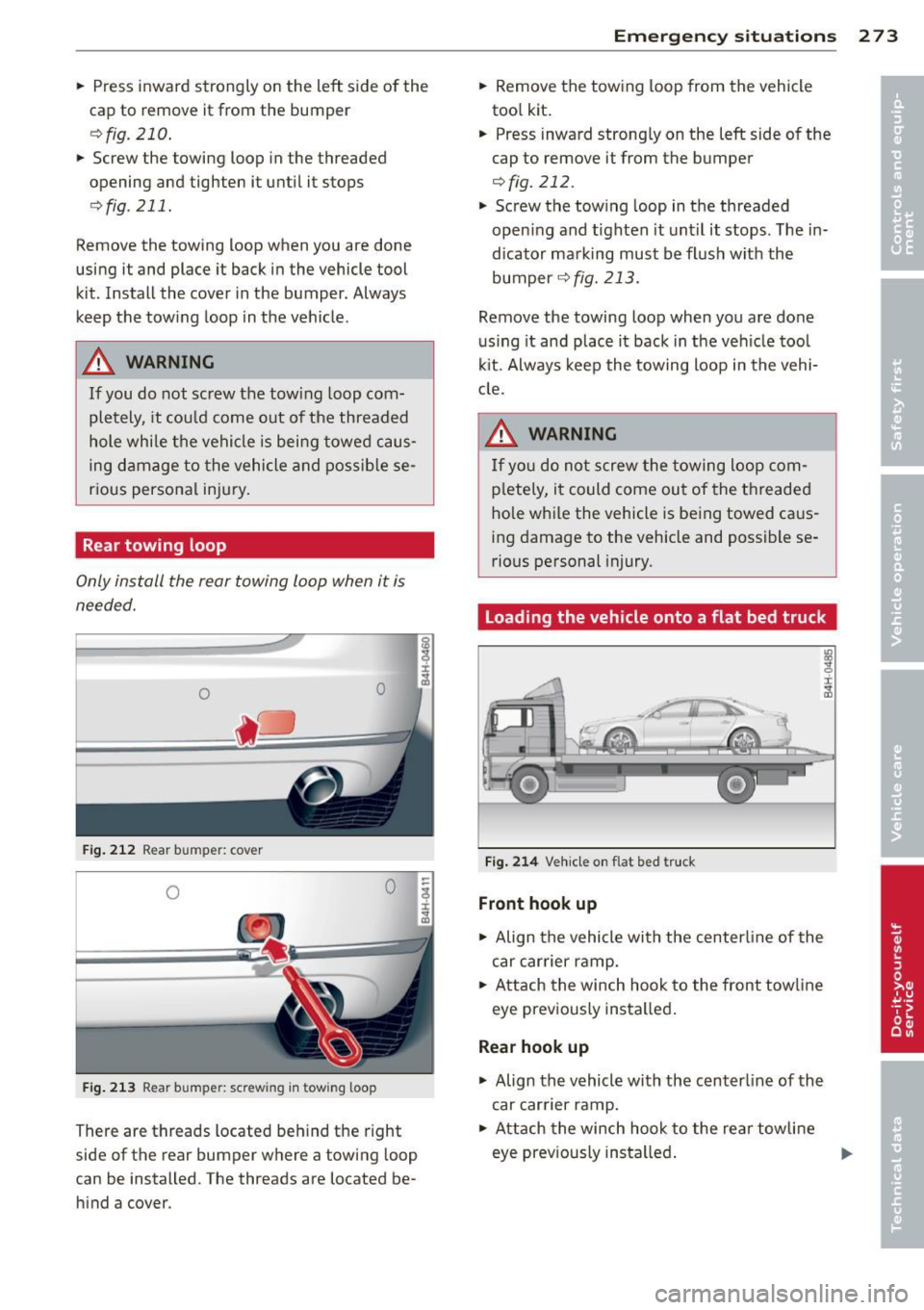
.. Press in ward strongly on the left side of the
cap to remove it from the bumper
e::>fig . 210 .
.. Screw the towing loop in the threaded
opening and tighten it until it stops
e::> fig . 211.
Remove the towing loop when you are done
using it and place it back in the vehicle tool
kit. Install the cover in the bumper. Always
keep the towing loop in the vehicle .
..&_ WARNING
If you do not sc rew the tow ing loop com
pletely, it cou ld come out of the threaded
hole while the vehicle is bei ng towed caus
ing damage to the vehicle and possib le se
r ious perso nal injury .
Rear towing loop
Only install the rear towing loop when it is
needed.
0 0
Fig . 212 Rear bumper: cover
0 0
Fig. 21 3 Rear bumper : screw ing in towing loop
There are threads located be hind the right
side of the rear bumper where a towing loop
can be installed. The threads are located be
hind a cover.
-
Emergenc y situ ation s 2 7 3
.. Remove the tow ing loop from the vehicle
too l kit .
.. Press inward strongly on the left side of the
cap to remove it from the bumper
¢fig. 212.
.. Screw the towing loop in the threaded
open ing and t ighten it unt il it stops. The in
dicator ma rking must be f lush with the
bumper
e::> fig. 213.
Remove the towing loop when you are done
us ing it and place it back in the ve hicle too l
ki t. Always keep the towing loop in the vehi
cle.
..&_ WARNING
If yo u do not s crew the towing loop com
p letely , it co uld come ou t of the t hreaded
hole while the vehicle is be ing towed caus
ing damage to the vehicle and possible se
rious pe rsonal injury.
loading the vehicle onto a flat bed truck
Fi g. 21 4 Ve hicle on flat bed tru ck
Front hook up
.. Align the vehicle wi th the centerline of the
car car rier ramp .
.,. Attach the winch hook to the front tow line
eye prev iously insta lled .
Rear hook up
.,. Align the vehicle with the c enter line of the
car earner ramp .
.. Attach the winch hook to the re ar towli ne
eye prev ious ly insta lled .
Page 276 of 300

2 7 4 Emergency situations
@ Tips
Check carefully to make sure the hook-up
is secure before moving the car up the flat
bed truck ramp.
Vehicle transport
Whenever you have your vehicle transported,
be sure to note the following:
(D Note
Mount the tie-down chains/cables over the
running surface (circumference) of the
tires. Never secure the vehicle by the axle,
the suspension struts or the front or rear
towline eye. For technical reasons, the
pressure in the suspension struts may
change during the transport and this will
adversely affect vehicle handling.
Lifting vehicle
Lifting with workshop hoist and with
floor jack
The vehicle may only be lifted at the lifting
points illustrated.
Fig. 215 Front lift in g po int
Fig. 216 Rear lifti ng point
.,. Read and heed WARNING ¢ _&.
.,. Activate the vehicle jack mode in the MMI :
!CARI function button > Car systems control
button
> Servicing & checks > Air susp.:
jack mode
> On.
.,. Locate lifting points ¢ fig . 215 and
¢fig. 216 .
.,. Adjust lifting arms of workshop hoist or
floor jack to match veh icle lifting points .
.,. Insert a rubber pad between the floor jack/
wo rkshop hoist and the lifting points.
The vehicle jack mode must be act ivated so
that the automat ic adjustment of the Adap
tive Ai r Suspens ion does not make it more dif
ficult to raise the vehicle with the floor jack.
If you must lift your vehicle with a floor jack
to work underneath, be sure the vehicle is
safely supported on stand s intended for this
purpose.
Front lifting point
The lifting point is located on the floor pan re
i nforcement about at the same level as the
jack mounting point
¢ fig. 215 . Do not lift
the vehicle at the vertical sill reinforcement.
Rear lifting point
The lifting point is located on the vertical rein
forcement of the lower sill for the on-board
jack
¢fig. 216.
Lifting with vehicle jack
Refer to ¢page 262.
A WARNING ,= -
-To reduce the risk of serious injury and
veh icle damage.
- Always lift the vehicle only at the spe
cia l workshop hoist and floor jack lift
points illustrated
¢ fig . 215 and
¢ fig. 216 .
-Failure to lift the vehicle at these
points could cause the vehicle to tilt or
fall from a lift if there is a change in ve
hicle weight distribution and balance.
This might happen, for example, when heavy components such as the eng ine
block or transmission are removed .
Page 277 of 300
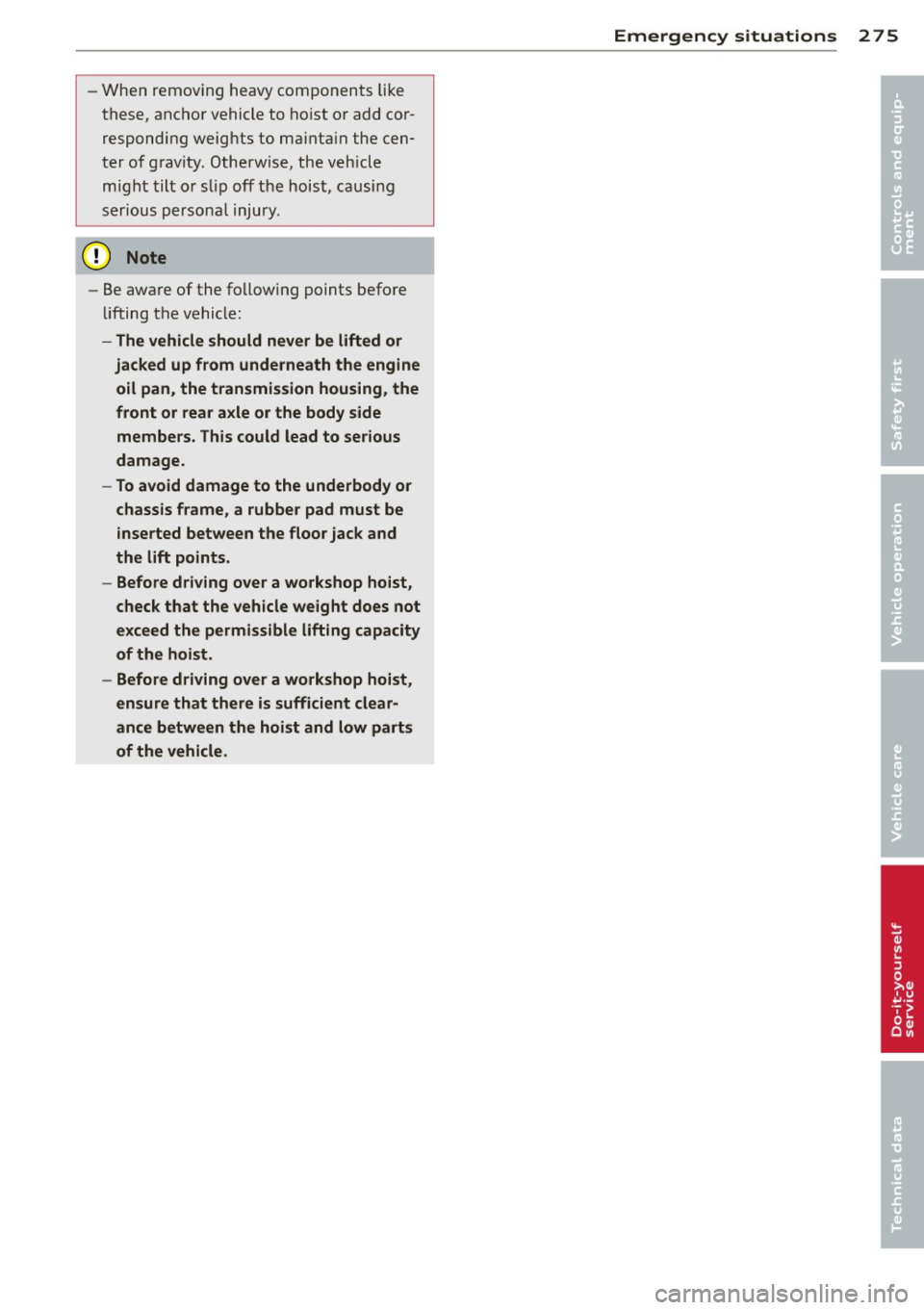
-When removing heavy components like
these, anchor vehicle to hoist o r add cor
respond ing weig hts to mai nta in the cen
ter of g ravity. Otherwise, the vehicle
m ight tilt o r sli p off the hoist, causi ng
serious p ersona l injury .
Q) Note
-Be awa re of the fo llowing points befo re
li fting t he vehicle:
- The vehicle should never be lifted or
jacked up from underneath the engine
oil pan, the transmission housing , the
front or rear axle or the body side members. This could lead to serious
damage.
- To avoid damage to the underbody or
chassis frame, a rubber pad must be
i nserted between the floor jack and
the lift points .
- Before driv ing over a wo rkshop hoist,
check that the veh icle weight does not
exceed the permissibl e lifting capacity
of the hoist.
- Before driving over a workshop hoist,
ensure that there is sufficient clear ance between the hoist and low parts
of the vehicle.
Emergency situations 275
•
•
Page 278 of 300
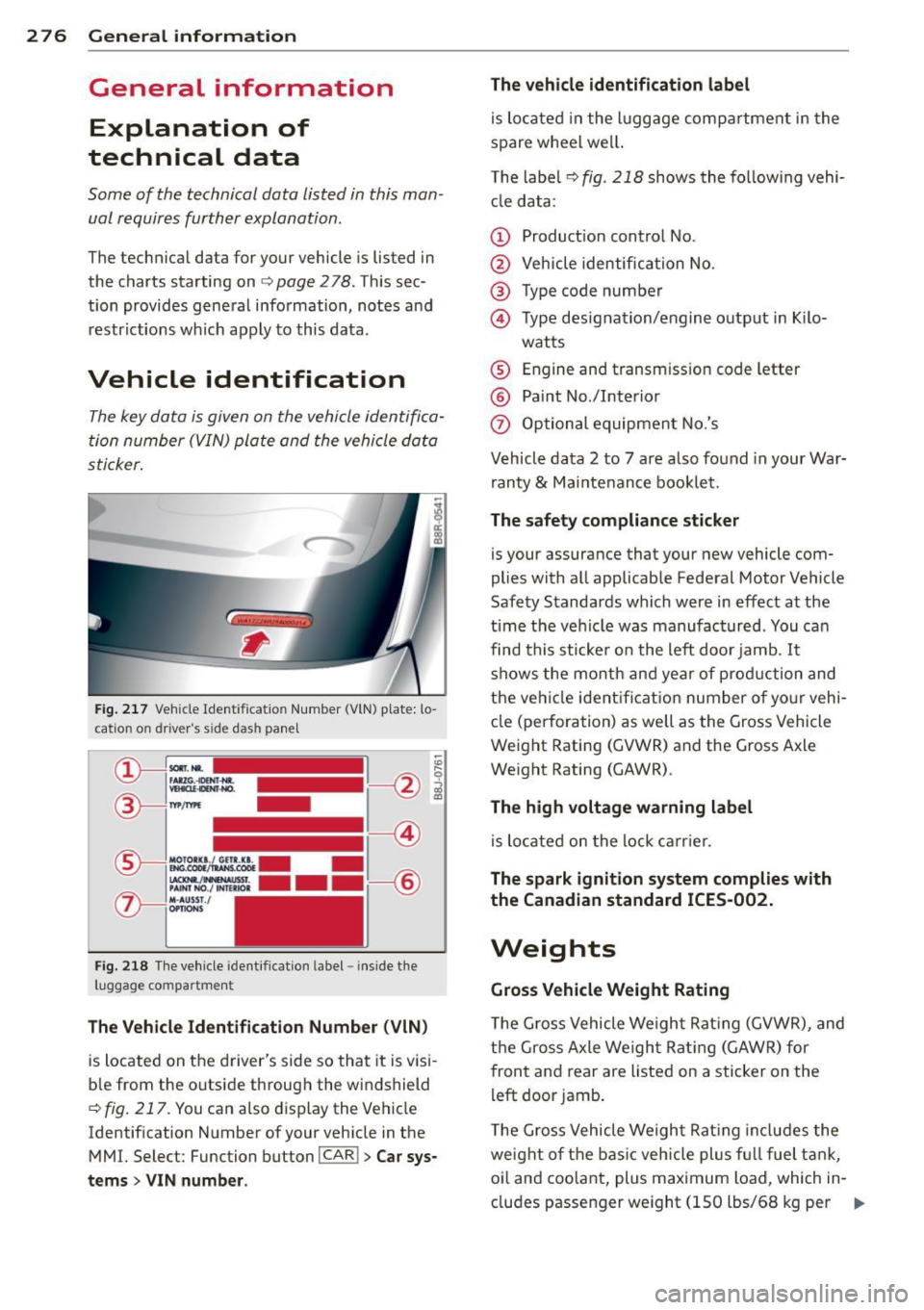
2 76 Genera l in formati on
General information
Explanation of
technical data
Some of the technical data listed in this man
ual requires further explanation .
The technical data for your vehicle is listed in
the charts starting on
r:::> page 2 78. This sec·
tion provides general information, notes and restrictions wh ich apply to this data .
Vehicle identification
The key data is given on the vehicle identifica·
tion number (VIN) plate and the vehicle data
sticker .
Fig. 2 17 Veh icle Ide ntific atio n Number (V lN) p late: lo
cation on driver's sid e das h panel
Fig . 2 18 The ve hicle identi fication label -inside the
luggage co mpa rtmen t
The Vehicle Iden tification Numb er (VIN )
is located on the driver's side so that it is vis i
b le from the outside through the windshield
r:::> fig . 217 . You can a lso display the Vehicle
Identification Number of your vehicle in the
MMI. Select: Function button
I CAR ! > Car s ys
t e ms
> V IN numb er. The
vehicl e identification labe l
is located in the luggage compartment in the
spare wheel wel l.
T he labe l¢
fig. 218 shows the fo llowing vehi
cl e data :
(D Product ion control No .
@ Vehicle identification No.
® Type code number
@ Type designation/engine output in K ilo·
wat ts
® Engine and transmission code letter
@ Paint No./Interior
(f) Optional equipmen t No.'s
Vehicle data 2 to 7 are also found in your War·
ran ty
& Ma intenance booklet.
The safety compliance stick er
is your assurance that your new vehicle com
plies with all applicable Federal Motor Vehicle
Safety Standards which were in effect at the
time the vehicle was manufac tured . You can
find this sticker on the left door jamb .
It
shows the month and year of production and
the ve hicl e ident ificat ion number of yo ur vehi ·
cle (perforation) as well as the G ross Vehicle
Weight Rating (GVWR) and the Gross Axle
Weight Rating (GAWR) .
The high volta ge warning label
is loca ted on the lock ca rr ier .
The spark ignition s ystem complies w ith
the Canadian standard ICES -002.
Weights
Gr oss V ehicl e Weight Rating
The Gross Vehicle Weight Rat ing (GVWR), and
t h e Gross Axle Weight Rating (GAWR) for
front and rear are Listed on a sticker on the
left door jamb .
T he Gross Vehicle Weight Rat ing includes the
weight of the bas ic vehicle plus fu ll fuel tank,
oi l and coo lant, plus maximum load , wh ich in·
eludes passenger weight (lSO lbs/68 kg per
Ill>
Page 279 of 300
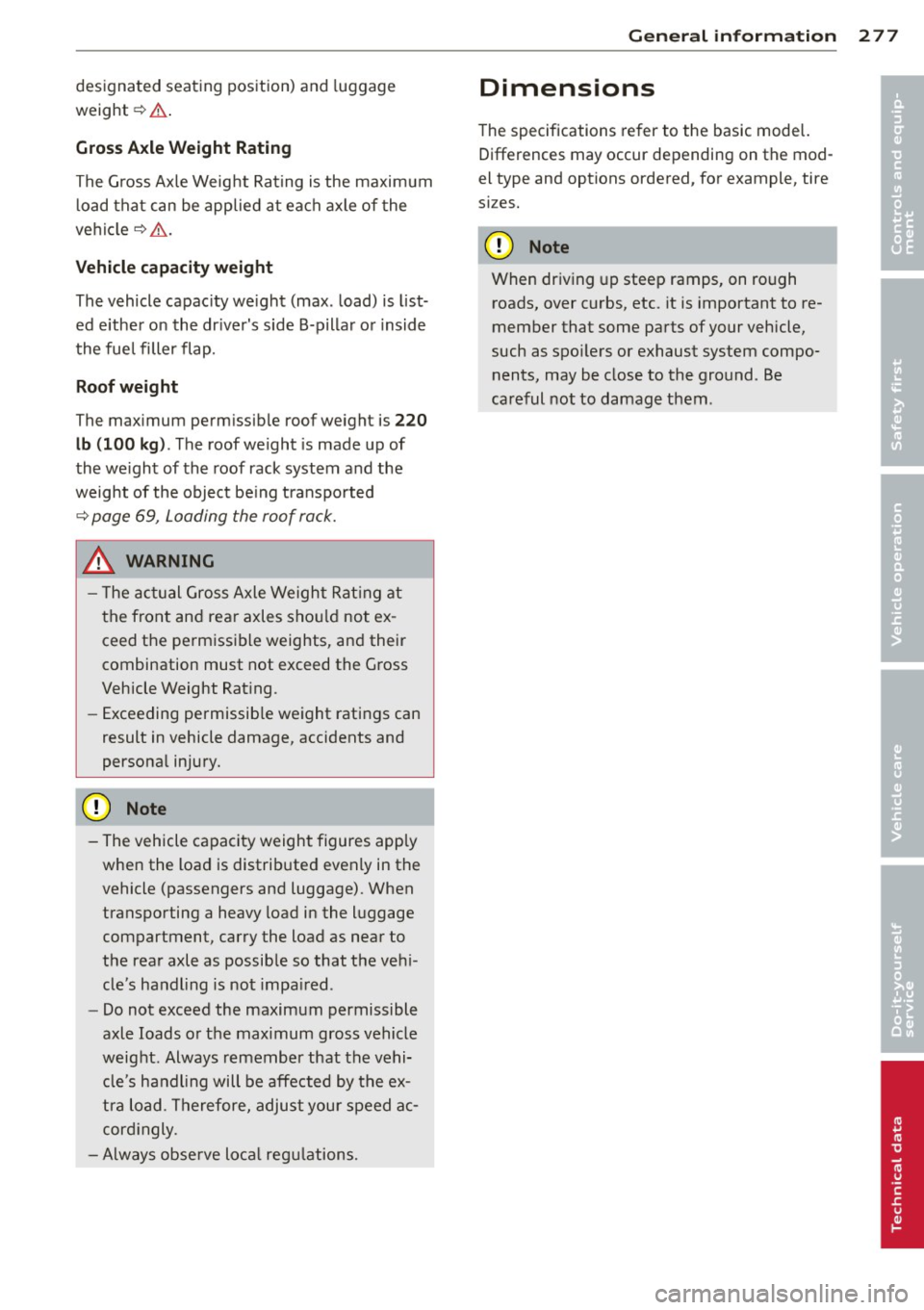
designated seating position) and luggage
weight~&. .
Gros s Axle W eight Rating
The G ross Axle Weight Rating is the maximum
l oad tha t can be applied at each axle of the
vehicle
q .&. .
Vehicle capacit y weight
The vehicle capac ity we ight (max. load) is list
ed either on the dr iver's side B-pillar or inside
the fuel filler flap.
Roof weight
The max imum perm issible roof weight is 220
lb (100 kg ).
The roof weight is made up of
the we ight of the roof rack system and the
weight of the object be ing transported
q page 69, Loading the roof rack .
.&, WARNING
- T he ac tual Gross Axle Weight Rat ing at
the front and rear axles shou ld not ex
ceed the permiss ible weights, and their
combination must not exceed the Gross
Vehicle Weight Rat ing .
- Exceeding permissib le weight ratings can
result in vehicle damage, accidents and
personal injury.
CD Note
- The vehicle capacity weight figures apply
when the load is distributed evenly in the
vehicle (passengers and luggage). When
transporting a heavy load in the luggage
compartment, carry the load as near to
the rear axle as possib le so that the veh i
cle's handling is not impa ired.
- Do not exceed the maximum permissible
axle loads or the maximum gross vehicle
weight. Always remember that the vehi
cle's handling will be affected by the ex
tra load. Therefore, adjust you r speed ac
cord ingly.
- Always observe loca l regu lations.
-
G ene ral in formation 2 77
Dimensions
The specifications refer to the basic model.
Differences may occur depending on the mod
el type and options ordered, for example, tire
sizes.
CD Note
When driving up steep ramps, on rough roads, over curbs, etc. it is important to re
member that some parts of your vehicle,
such as spoilers or exhaust system compo nents, may be close to the ground . Be
careful not to damage them .
•
•
Page 280 of 300
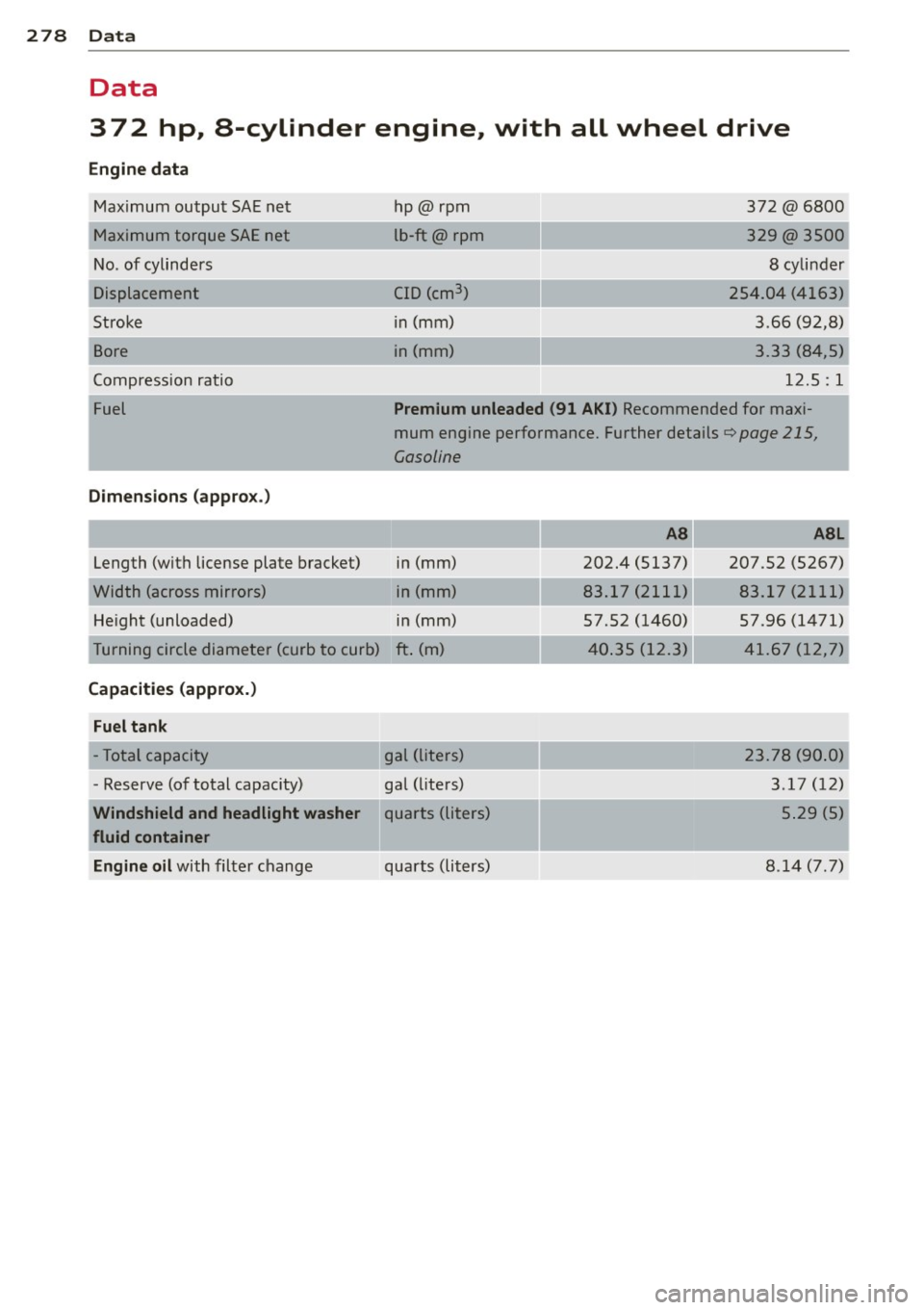
278 Data
Data
372 hp, a-cylinder engine, with all wheel drive
Engine data
Maximum output SAE net
Maximum torque SAE net
No. of cylinders
Displacement
Stroke
Bore
Compression ratio hp@rpm
l
b-ft@ rpm
CID (cm
3 )
in (mm)
i n (mm)
372 @6800
329@3500
8 cylinder
254.04 (4163)
3.66 (92,8)
3.33 (84,5)
12.5 : 1
Fuel Premium unleaded (91 AKI) Recommended for maxi
mum engine performance. Further details¢
page 215,
Gasoline
Dimens ions (appro x.)
Length (with license plate bracket) in (mm)
Width (across mirrors) ____ in (mm)
He ight (unloaded) in (mm)
Turning circle diameter (curb to curb) ft . (m)
Capacities (approx.)
Fuel tank
- Total capacity gal (liters)
- Reserve (of total capacity) gal (liters)
Windshield and headlight washer quarts (liters)
fluid container
Engine oil
with filter change quarts (liters)
AS ASL
202.4 (5137) 207.52 (5267) _,, __
83.17 (2111) 83.17 (2111)
57 .52 (1460) 57.96 (1471)
4 0.35 (12.3) 41.67 (12,7)
23. 78 (90 .0)
3.17 (12)
5.29 (5)
8 .14 (7 .7)